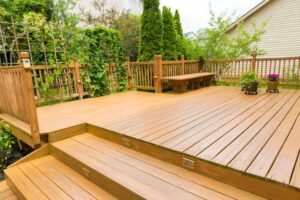On the surface Landscaping Harrisburg PA appears simple, but it involves much more than just placing a few plants and trees. A well conceived landscape design should be functional and easy to maintain.

Ideally, you should look at your yard at different times of day and in varying weather conditions to see how your landscape looks. Look at neighboring properties, botanical gardens and estate gardens for ideas as well.
Lawns are the most common part of residential landscapes and can be used in many ways. Often, they serve as the base of the landscape, where shrubs, flower beds and trees are placed to complement it. They also provide an area for children and pets to play and enjoy the outdoors. Keeping grass healthy and aesthetically pleasing helps increase property values, according to research done by the National Association of Landscape Professionals.
Many homeowners association rules (HOA) and city codes require the use of fertilizers, weed killers, and pesticides on lawns. These chemicals are harmful to humans and wildlife and can cause skin irritation, eye damage, and even cancer. In addition, they can be carried into rivers and lakes where they can harm water quality.
Using alternative landscaping practices to reduce the amount of lawn and replace it with native plants is one way to help preserve biodiversity and keep our environment healthy. However, it can be difficult to get people to break away from a culture that promotes and reveres the lush green lawn as a status symbol. Fortunately, interest in Environmental Sustainability (ES) is growing and people are beginning to question the need for such high-maintenance stretches of grass.
There are a number of reasons why replacing traditional lawns with native plant species is an effective strategy to fight climate change. Not only will it reduce the amount of water needed to maintain them, but it will also encourage a healthier ecosystem with less pollution, erosion and disease.
For instance, removing turfgrass and substituting it with a meadow full of wildflowers will attract beneficial insects such as bees and butterflies that can pollinate other plants. It will also provide a habitat for reptiles and small mammals, and it can prevent the loss of valuable soil to runoff and stormwater management.
Lawns can also have a positive impact on the surrounding environment by reducing noise levels and acting as an air conditioner. Grass absorbs and dissipates sound through a process called evapotranspiration, making it much cooler than paved surfaces. This is especially helpful during hot weather, when it can be uncomfortable to walk barefoot on sidewalks and streets.
Shrubs
The addition of shrubs brings color, texture and form to the landscape. They are useful for creating borders, accenting pathways, framing outdoor rooms and drawing attention to garden features. Many also provide important functional roles as screening, sound reduction and erosion control.
Shrubs are woody plants with several stems and can be deciduous (drop their leaves in the winter) or evergreen. They come in a wide variety of shapes and sizes, from tall tree-like specimens to low groundcovers. There are even coniferous shrubs, such as yew and juniper, which are often used to create privacy hedges.
Planting shrubs at the proper height and spacing is vital for an attractive landscape. The space between each shrub should be no closer than one-half their ultimate spread. Planting shrubs too close together can block out sunlight to other parts of the landscape or shade them out, which may not be desirable. In addition, taller shrubs may overshadow smaller flowers and groundcovers.
A well-planted shrubbery can add interest throughout the year. Many types of flowering shrubs, such as rhododendron and lilac, provide vibrant color in the spring. They can also be used to form colorful hedges. Alternatively, you can try flowering shrubs that are not known for their blooms but produce interesting bark textures or solid green foliage, such as hydrangea, nandina and pygmy holly.
Hedges of yew, holly or other evergreen shrubs can add structure to the garden and help delineate spaces. They can also screen out unwanted views or provide a backdrop for garden structures. Low shrubs, such as periwinkle or thyme, are popular choices for adding color and texture to the landscape, while also acting as a groundcover. For a more formal look, shrubs can be planted in linear rows. This can work especially well in areas where you want to create a defined garden border or fence. However, more informal groupings of shrubs are often a better choice for blending them into the surrounding natural environment. Many native shrubs are available for landscaping and tend to do best in the local climate.
Trees
A well-placed tree can provide a variety of visual, functional and environmental benefits. From the beauty of vibrant fall colors to summer shade and year-round greenery, deciduous trees add depth and contrast to a landscape. Evergreens offer visual continuity and act as natural privacy barriers. And, the extensive root systems of some species stabilize soil, prevent erosion and reduce water runoff. Trees also help to improve air quality by reducing carbon dioxide emissions and acting as natural pollution filters.
Trees are an integral part of every home landscape. Their size and scale can influence how a property feels. They can emphasize or de-emphasize the home, depending on their distance from the house and the size of their mature canopy. In addition, trees can define space and provide privacy by creating walls of shade or screening. A landscape professional can help homeowners determine which trees are best suited for their properties.
When choosing a new tree, consider its shape, color and texture as well as its growing zone, soil conditions and climate. Also, keep in mind that the type of pruning required will impact the shape of the tree as it grows. Once a selection is made, the landscaper will prepare the site and plant the new specimen with the desired spacing and pruning plan in place.
Landscape professionals are experts at cultivating beautiful, healthy landscapes that complement the existing architecture of homes and buildings. They are also familiar with the best practices for eco-friendly lawn care, integrated pest management, biodiversity and sustainable landscaping. They will ensure that the new landscape design is based on sound principles and meets all local building codes and ordinances.
A professionally-designed and maintained yard can increase your property value. In addition to elevating curb appeal, tree-lined streets and well-landscaped yards make neighborhoods feel more established and welcoming. So, if you’re thinking about selling your home in the future, investing in attractive landscaping is an excellent way to boost its resale value.
Water features
Water features have become an integral part of many landscapes, as they add beauty and interest to outdoor spaces. They also provide a range of benefits that improve the quality of life for homeowners and their guests. Incorporating water elements into your landscaping design can help promote a healthy, thriving garden that is rich in biodiversity and ecological balance.
Water Features
There are dozens of different water feature options available to suit any style or budget, from simple fountains to elaborate natural ponds and waterfalls. A well-designed water feature can transform your backyard into a peaceful oasis. It’s important to choose a water feature that fits with your overall landscape design and architectural style. Proper maintenance can ensure your water feature is beautiful and functional for years to come.
Fountains are one of the most popular types of water features for homes, and they’re available in a wide variety of sizes and styles. From small tiered structures to large freestanding sculptures, these features add a sense of grandeur and can serve as an artistic focal point. If you’re looking for a more energy-efficient option, consider a solar-powered fountain.
Ponds and streams are another popular choice for homeowners who want to create a serene backyard retreat. Ponds and streams offer an opportunity to showcase lush plantings, while adding interest with the sound of flowing water. Ponds and water features that contain fish and other aquatic plants can even attract wildlife, such as birds and butterflies.
Waterfalls are a great way to bring a soothing ambiance to your home, and they can also be a centerpiece of your landscape. Waterfalls are typically made of rock or concrete, although you can find a more decorative option that resembles a waterfall in a natural setting.
The calming sound of running water and the mesmerizing interplay of light and shadow make water elements a stunning addition to any garden. These captivating focal points evoke a variety of moods, from a gentle brook to a dramatic fountain. By manipulating the flow, sound, and appearance of water elements, landscape designers create a symphony of visual and sensory delights.



